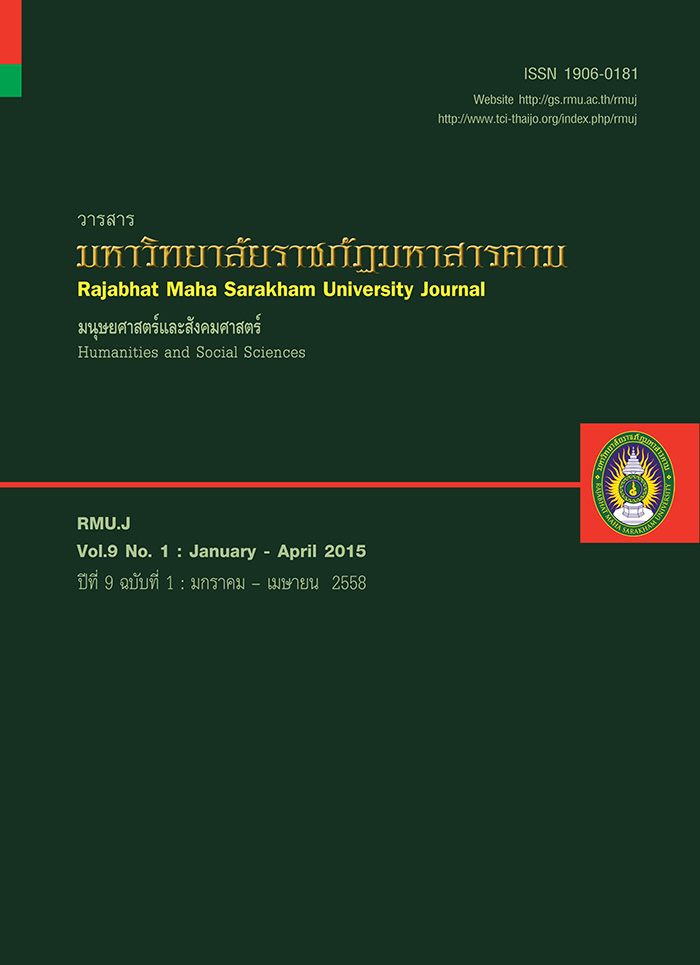รูปแบบการจัดทำและผลการใช้แหล่งเรียนรู้วิทยาศาสตร์ธรรมชาติท้องถิ่น จังหวัดมหาสารคาม;Development Models and Results of Using Local Natural Science Learning Resources in Maha Sarakham Province
Main Article Content
บทคัดย่อ
การวิจัยครั้งนี้มีวัตถุประสงค์เพื่อศึกษารูปแบบการจัดทำและผลการใช้แหล่งเรียนรู้วิทยาศาสตร์ธรรมชาติท้องถิ่น ในจังหวัด
มหาสารคาม ผู้ร่วมวิจัย ได้แก่ ครูระดับการศึกษาขั้นพื้นฐาน จำนวน 33 คน จาก 17 โรงเรียน และ นักศึกษามหาวิทยาลัยราชภัฏ
มหาสารคาม 43 คน แหล่งเรียนรู้วิทยาศาสตร์ธรรมชาติที่สำรวจในจังหวัดมหาสารคาม อยู่ในโรงเรียน 15 แห่ง และนอกโรงเรียน ได้แก่
วัดที่อยู่ใกล้โรงเรียน 4 แห่ง ป่าชุมชนและดอนปู่ตา 4 แห่ง และแปลงเศรษฐกิจพอเพียง 1 แห่ง ผลการสำรวจแหล่งเรียนรู้วิทยาศาสตร์
ธรรมชาติจากโรงเรียน ป่า และแปลงเศรษฐกิจพอเพียง พบเป็นไม้ยืนต้นและพืชสมุนไพร รวม 75 วงศ์ 226 ชนิด พืชที่พบมาก ได้แก่
วงศ์ FABACEAE (28 ชนิด), EUPHORBIACEAE (16 ชนิด), RUBIACEAE (13 ชนิด), และ RUTACEAE (10 ชนิด) โดยพบ
ประดู่บ้าน (Pterocarpus indicus Willd.) มากที่สุด คิดเป็นร้อยละ 80 ของจำนวนแหล่งที่สำรวจ ผลการศึกษาเกี่ยวกับรูปแบบ
การใช้แหล่งเรียนรู้วิทยาศาสตร์ครูวิทยาศาสตร์ใช้แหล่งเรียนรู้ธรรมชาติ ที่เป็นไปตามสภาพธรรมชาติ คิดเป็น ร้อยละ 84.6 โดยให้ผู้รู้
หรือภูมิปัญญาท้องถิ่นเป็นวิทยากรในการนำศึกษา คิดเป็นร้อยละ 80.8 เนื้อหาที่ใช้ในการจัดกิจกรรมการเรียนรู้ ทั้งระดับประถมศึกษา
และมัธยมศึกษา ส่วนใหญ่เป็นสาระการเรียนรู้ที่ 1 สิ่งมีชีวิตกับกระบวนการดำรงชีวิต และชีวิตกับสิ่งแวดล้อม ใช้ประกอบการสอน
เนื้อหา ร้อยละ 88.0 และเตรียมพร้อมในการทำโครงงานวิทยาศาสตร์ ร้อยละ 58.0 วิธีการสอนใช้การนำนักเรียนไปสำรวจแหล่งเรียน
รู้ภายในบริเวณโรงเรียนอยู่ระหว่าง 1- 32 ครั้ง/ปี เฉลี่ย 9.85 ครั้ง/ปี สำรวจแหล่งเรียนรู้ภายนอกบริเวณโรงเรียน เช่น วัด ดอนตาปู่
ป่าชุมชน หมู่บ้าน เป็นต้น อยู่ระหว่าง 0-20 ครั้ง/ปี เฉลี่ย 3.54 ครั้ง/ปี
This study aimed to develop models and study results of using local natural science learning resources
in Maha Sarakham Province. The research participants consisted of thirty three basic education teachers
from seventeen schools in Maha Sarakham, and forty three students of the Science Program from Faculty of
Education, Rajabhat Maha Sarakham University. The research sites were fifteen natural learning resources
in schools, four natural learning resources in temples, four community forests and one sufficient economybased
farm.
The finds showed that 75 families and 226 species of trees and medicinal plants were found in all
natural learning resources. The plant families and a number of species mostly found were FABACEAE with
28 species, EUPHORBIACEAE with 16 species, RUBIACEAE with 13 species, and RUTACEAE with 10 species.
The Pterocarpus Indicus Willd was mostly found at 80 percent of the study areas. With regard to the used of
science learning resources, it was found that science teachers uses of science learning resources in the
natural at 84.6 percent. The local scholars were invited as guide lectures at 80.80 percent. The contents
used for learning activity management at both primary and secondary levels found mostly were Living things
and Life Processes and Life and Environment. These resources were used as supplementary contents at
88.0 percent and as readiness preparation for science project development at 58.0 percent. These teaching
activities mostly implemented were the student survey of school resources at 1-32 times per year with an
average of 9.85 times/year, student survey of outside school resources such as temples, community forests,
village areas, at 0-20 times per year with an average of 3.45 times/year.
Article Details
1. บทความที่ลงตีพิมพ์ทุกเรื่องได้รับการตรวจทางวิชาการโดยผู้ประเมินอิสระ ผู้ทรงคุณวุฒิ (Peer Review) สาขาที่เกี่ยวข้อง อย่างน้อย 3 ท่าน ในรูปแบบ Double blind review
2. ข้อคิดเห็นใด ๆ ของบทความที่ลงตีพิมพ์ในวารสารมหาวิทยาลัยราชภัฏมหาสารคาม นี้เป็นของผู้เขียน คณะผู้จัดทำวารสารไม่จำเป็นต้องเห็นด้วย
3. กองบรรณาธิการวารสารมหาวิทยาลัยราชภัฏมหาสารคาม ไม่สงวนสิทธิ์การคัดลอกแต่ให้อ้างอิงแสดงที่มา


